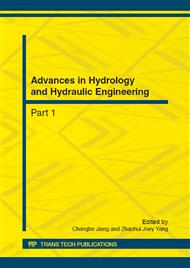p.151
p.155
p.163
p.169
p.177
p.181
p.186
p.193
p.201
One-Dimensional Soil Moisture Simulation Using Ensemble Kalman Filter
Abstract:
Data assimilation is a method which integrates model and observation. In hydrology, ensemble Kalman filter (EnKF) as a sequential data assimilation method is often used to correct model parameters, thus improve the simulated accuracy. In this study, we conduct one numerical experiment to predict soil moisture using the one-dimensional soil moisture system based on ensemble Kalman filter and Simple Biosphere (SiB2) Model at Meilin study area, China. The simulated period is divided into two parts: 0-60h and 60-240h. The results show that EnKF is an efficient method in assimilating the soil moisture, especially in soil surface layer and deep soil layer; in addition, the efficiency of EnKF depends on the selection of initial soil moisture profile. With different initial soil moisture profiles, the performance of EnKF is different at the first few assimilated time, but with time grows, it can improve the simulated accuracy significantly.
Info:
Periodical:
Pages:
177-180
Citation:
Online since:
October 2012
Authors:
Price:
Сopyright:
© 2012 Trans Tech Publications Ltd. All Rights Reserved
Share:
Citation:


